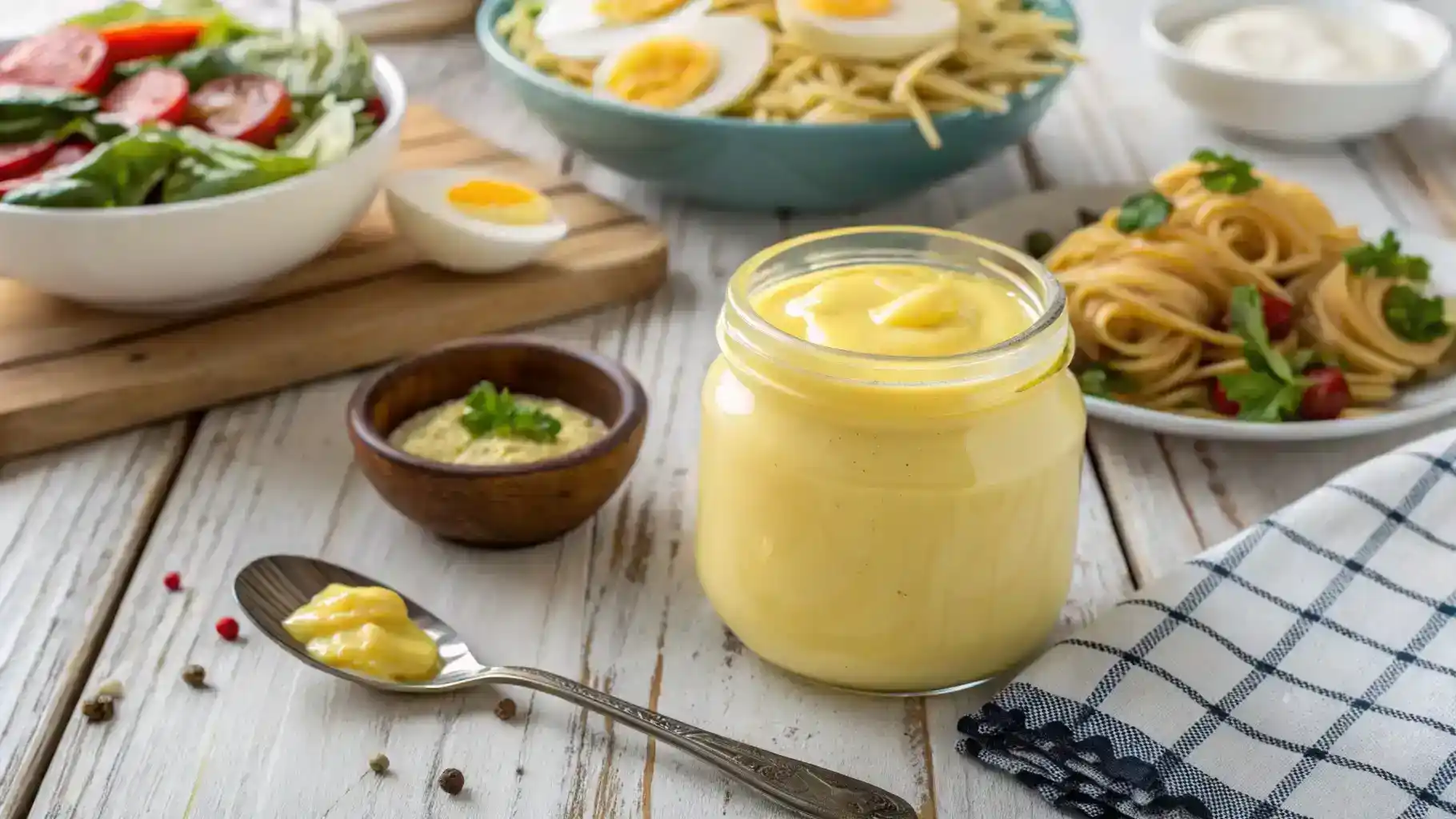Want to make fresh, creamy homemade mayonnaise in under 10 minutes with just a few basic ingredients?
Your typical store-bought mayonnaise contains questionable ingredients like added sugar, preservatives, and canola oil. Our homemade recipe uses only natural ingredients – a large egg, Dijon mustard, white vinegar, and neutral oil. An immersion blender makes this process almost foolproof and takes just one minute to create perfect results.
The recipe’s success comes from a clever trick. Use a jar that’s just slightly bigger than your immersion blender’s head. This will give you properly emulsified and creamy mayonnaise that stays fresh up to two weeks in your fridge – though it tastes so good, it probably won’t last that long!
Want to make mayonnaise that’s fresher, healthier, and tastier than anything from the store? Let’s begin!
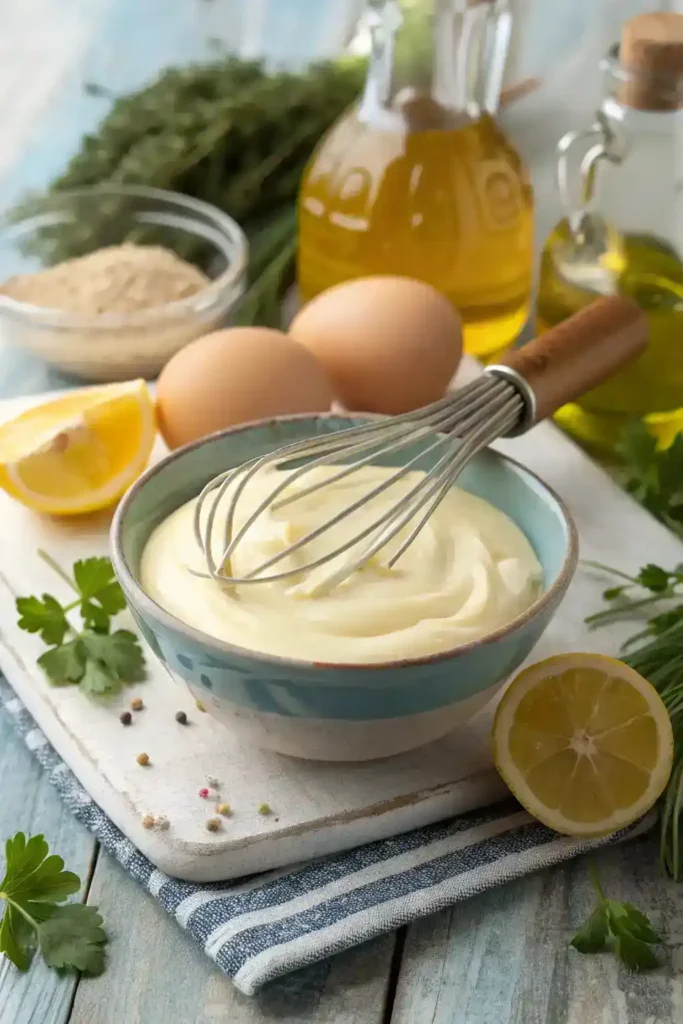
Table of Contents
Why Homemade Mayonnaise Beats Store-Bought Every Time
The joy of making mayonnaise at home goes beyond the satisfaction of creating something from scratch. I started making my own mayo and found so many benefits that store-bought versions are nowhere near as good. Let me share why homemade mayo stands out in health, cost, and taste.
Health benefits of homemade mayo
You get to control everything that goes into your mayo when you make it at home. Store-bought mayo usually contains preservatives, stabilizers, and added sugar. So, making mayo at home lets you skip those unnecessary additives that make it last up to one year.
The quality of oil makes a huge difference. Commercial brands stick to soybean or canola oil, but you can choose better options. Good-quality olive oil works great (just not extra-virgin as it tastes bitter). Avocado oil is another option that gives you heart-healthy unsaturated fats.
Fresh eggs are game-changers too. You can use pasture-raised eggs that have a much lower salmonella risk than regular store eggs. These fresh eggs pack important nutrients like vitamin E for heart health and vitamin K that helps blood clot.
We focused mainly on avoiding harmful ingredients. Your homemade mayonnaise skips all those chemicals and gut irritants you’ll find in commercial versions.
Cost comparison: homemade vs. store-bought
The cost debate has different sides. One study shows homemade mayonnaise costs about 14 cents per ounce while Hellmann’s costs 27 cents—making homemade nearly 50% cheaper. Another report says homemade mayo saves you 37% compared to store versions.
In stark comparison to this, some sources claim homemade mayo costs more. They found it costs around USD 2.20 per cup while store-bought costs USD 1.30. Your original investment in quality ingredients might make the first batch pricier, even if it saves money later.
Most experts agree that these small price differences don’t matter much compared to the quality you get. Families who use mayo often find homemade versions worth every penny.
Flavor difference you’ll notice immediately
The taste gap between homemade and commercial mayo might be the best reason to make your own. Homemade mayonnaise gives you:
- A fresher, eggier flavor with natural tang
- A lighter, silkier, more delicate consistency
- A creamier, richer texture without processed aftertaste
Your homemade mayo opens up endless possibilities for customization. You can play with acidity using different vinegars or lemon juice, add mustards for kick, or mix in herbs and spices. This flexibility makes homemade mayo shine in dishes where its “fresh, creamy texture and bright flavor can shine”.
Mayo skeptics often change their minds after trying fresh mayo. One former mayo-hater admitted, “I hated mayo. Then I tried making it myself and I was converted”. You’ll notice the biggest difference when using it as a dip or in recipes where mayo plays a starring role.
Homemade mayonnaise adds depth that revolutionizes everything from sandwiches to potato salads. This difference matters most to food lovers who appreciate subtle flavors and want their condiments to boost rather than just accompany their food.
Essential Ingredients for Perfect Homemade Mayo
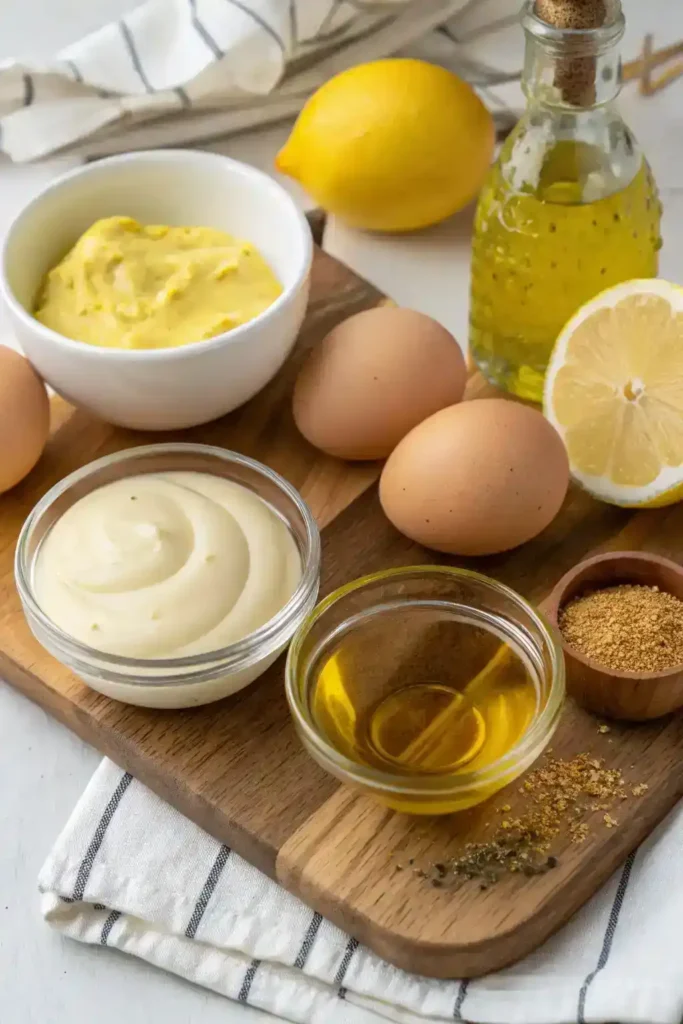
Making a delicious homemade mayonnaise recipe requires an understanding of its ingredients. The quality and amounts of each ingredient shape the flavor, texture, and stability of your mayo.
Choosing the right oil
Your easy mayo recipe success depends on the oil you pick. A mild, neutral-flavored oil creates that classic mayonnaise taste:
- Extra light olive oil gives you a smooth texture without an overwhelming olive taste
- Avocado oil packs heart-healthy fats but watch out for brands with stronger flavors
- Sunflower or safflower oil give you neutral bases with smooth textures
In spite of that, extra-virgin olive oil doesn’t work well for traditional mayo because its strong flavor takes over. One expert puts it simply: “The main ingredient in mayonnaise is oil, so choose a high-quality one”. The oil should stay liquid when cold to mix properly.
Fresh eggs: why quality matters
Eggs work as the significant emulsifier in mayonnaise. The lecithin in egg yolks keeps oil and vinegar from separating. You can use whole eggs or just yolks:
- Whole eggs make it lighter and fluffier
- Egg yolks alone give you a richer, thicker mayonnaise
Fresh eggs make a real difference in safety and quality. “Using the freshest ingredients and tailoring the ingredients to suit your palate will yield creamy mayonnaise that tastes much better than anything you can buy in the store”. You might want to try pasteurized eggs that have been treated to kill bacteria without cooking.
Acid options: lemon juice vs. vinegar
Acids serve two purposes in homemade mayonnaise – they improve flavor and help it last longer. Your choice between lemon juice and vinegar changes the final taste:
Lemon juice gives a bright, citrusy freshness that “brightens up” mayonnaise. It helps break down egg yolks so they mix better. Fresh squeezed lemon juice tastes best, but bottled works too.
Vinegar adds a neutral tang and helps preserve the mayo. Its acidity stops bacteria from growing. White wine vinegar tastes milder than regular white vinegar and adds subtle complexity.
The best results often come from using both acids – vinegar to preserve and lemon to brighten.
Optional flavor enhancers
Your homemade mayonnaise recipe can taste even better with these additions:
Dijon mustard adds flavor and helps ingredients mix well. “Mustard adds a bit of flavor, but it also helps to keep the mayonnaise stable”. A small amount helps prevent separation, even if you’re not big on mustard.
Salt lifts all other flavors while sugar makes it taste more like store-bought mayo. “I’m convinced it’s the secret ingredient to make it taste more like the popular mayonnaise brands such as Hellmans or Best Foods”.
Once you become skilled at making the simple easy homemade mayonnaise recipe, try these creative twists:
- Garlic and extra lemon juice for aioli
- Smoked paprika for a Spanish-inspired version
- Sriracha or chipotle for spicy mayonnaise
- Fresh herbs like dill, basil, or tarragon
These quality ingredients will help you make perfect homemade mayonnaise that tastes better than anything from the store.
The 2-Minute Immersion Blender Method
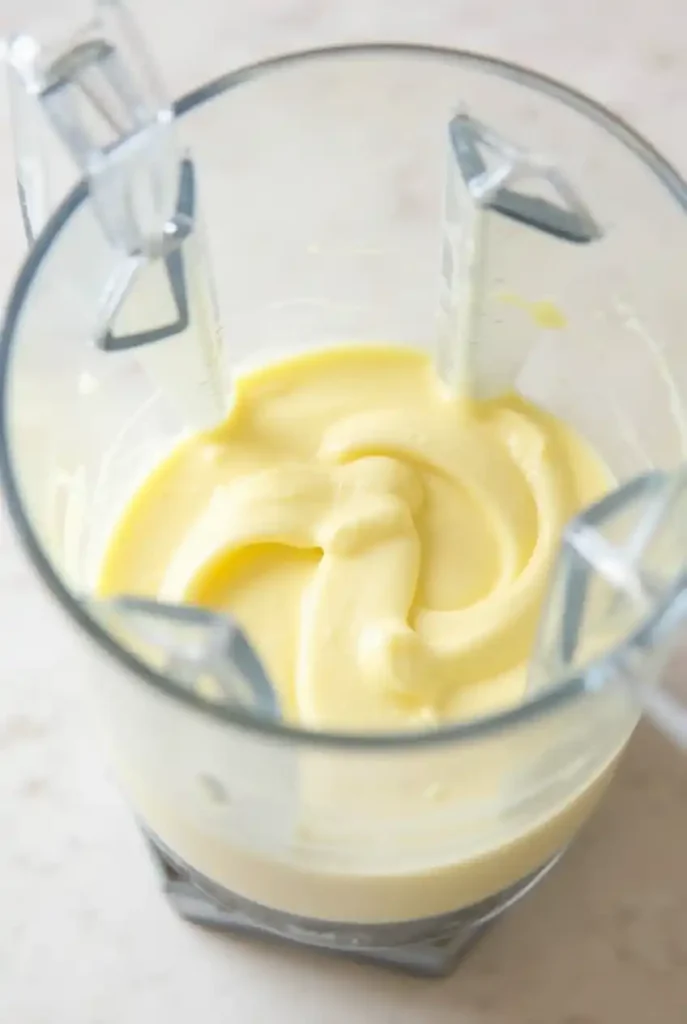
Making mayonnaise at home has become so much easier with the immersion blender method. You can now skip the tedious oil-drizzling process and make perfect mayo in just two minutes. Let me share my simple technique that works every time.
Equipment you’ll need
These tools will help you make this easy mayo recipe:
- An immersion blender (also called a stick blender)
- A tall, narrow container – the one that came with your blender works best
- Measuring cups and spoons
Your container choice is vital – it should be just slightly wider than your immersion blender’s head. This creates the right vortex needed to mix everything. The recipe might fail if you use a container that’s too wide. The narrow jar helps the egg and oil mix together smoothly as you blend.
Setting up your ingredients correctly
The success of this homemade mayonnaise recipe blender method depends on how you arrange your ingredients:
- Put your egg (or just yolks) at the bottom of the jar
- Add seasonings (salt, mustard, acid) right on top of the egg
- Pour all the oil on top and wait 15-30 seconds for ingredients to settle
You don’t need to add the oil slowly like traditional recipes – just pour it all at once! Room temperature ingredients work best, especially the egg. You can quickly warm up a cold egg by placing it in lukewarm water.
The blending technique that never fails
Here’s my trusted method to make homemade mayonnaise:
- Put the immersion blender at the jar’s bottom so it covers the egg completely
- Switch the blender to high speed but keep it still
- Keep it steady for 10-15 seconds until white mayonnaise starts forming
- Once the bottom part becomes thick and white, lift the blender up slowly about an inch
- Keep moving upward slowly until all oil mixes in
The magic happens when you keep the blender still at first! This creates a vortex that pulls oil down into the egg mixture. The blender pulls down oil in a thin stream, doing all the hard work.
This easy homemade mayonnaise recipe gives you perfect mayo in less than a minute. Just transfer it to a glass jar with a lid and refrigerate right away.
Troubleshooting Your Homemade Mayonnaise Recipe
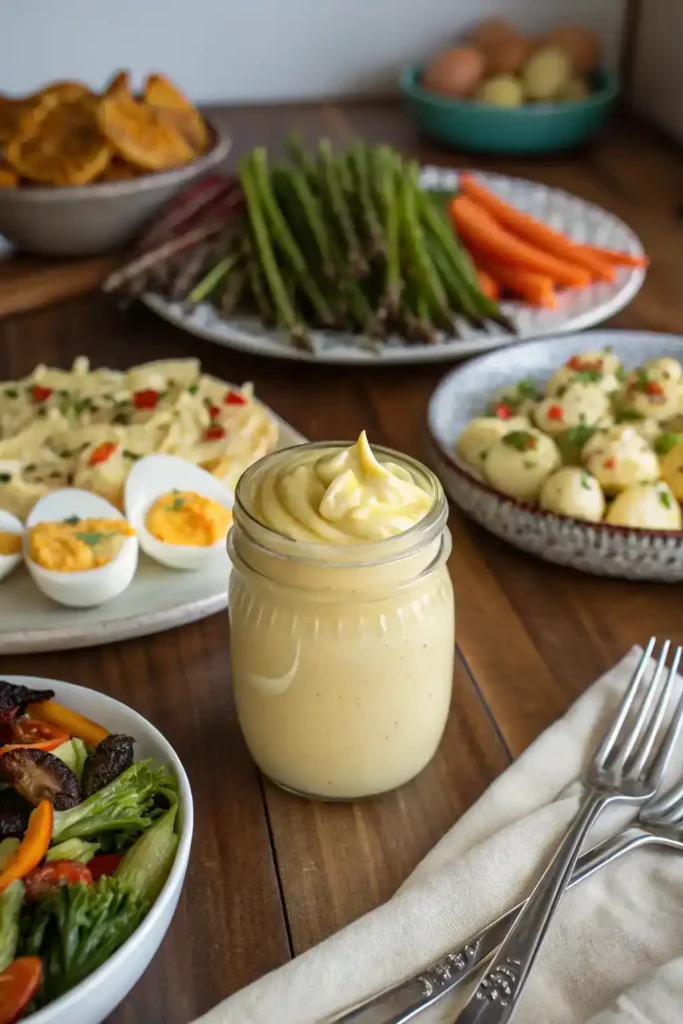
Perfect recipes can fail sometimes, and homemade mayonnaise is no different. You’ll become a more confident cook by learning how to spot and fix common mayo problems.
Why mayo sometimes breaks
Homemade mayonnaise “breaks” when the emulsion fails and ingredients separate. Here are the most important reasons behind this frustrating problem:
- Cold ingredients: Room temperature components play a vital role since cold eggs often prevent proper emulsification
- Oil added too fast: The emulsifiers in the egg get overwhelmed if you pour all the oil at once
- Incorrect proportions: The mixture becomes unstable with too much oil compared to egg yolk and acid
- Poor quality eggs: Fresh eggs have stronger lecithin, which is your mayonnaise’s natural binding agent
Your homemade mayonnaise recipe has broken if it looks curdled and you can see oil separating from the mixture.
How to fix broken mayonnaise instantly
The good news is that fixing broken mayo doesn’t take much effort. These methods work well:
The egg yolk rescue: Start with a fresh room-temperature egg yolk in a clean bowl. Whisk the broken mayonnaise in slowly, just as you would add oil in the original recipe. This fresh emulsifier helps combine the separated ingredients.
The boiling water trick: Mix 1-2 teaspoons of boiling water into your broken mayo and blend right away. The heat cooks the eggs slightly and helps restore the emulsion without changing the consistency.
The mustard method: Put a teaspoon of Dijon mustard in a clean bowl and mix in the broken mayo bit by bit. Mustard works as an extra binding agent to bring the ingredients back together.
Adjusting thickness and consistency
If your easy homemade mayonnaise recipe is too thin but not broken:
- Blend in more oil gradually until it thickens
- Add another egg yolk to thicken it substantially
- Use extra mustard to improve both texture and flavor
If your mayo is too thick:
- Blend in 1-2 teaspoons of cold water
- Add more acid (lemon juice or vinegar) to thin it out and enhance the taste
Your properly emulsified homemade mayo recipe needs to go in the refrigerator right after you make it to stay safe and keep its texture.
Storing and Using Your Easy Mayo Recipe
After you become skilled at making your homemade mayonnaise recipe, proper storage and creative uses will maximize your creation’s potential. Fresh, creamy mayo creates countless culinary possibilities beyond a simple sandwich spread.
Proper storage containers and shelf life
Glass containers with tight-fitting lids work best to store your easy homemade mayonnaise recipe. The natural acidity helps preserve mayo, but without commercial preservatives, homemade versions don’t last as long. Your homemade mayo recipe typically lasts about two weeks in proper refrigeration.
A surprising trick can extend the shelf life: add a tablespoon of yogurt whey (the liquid that separates in yogurt) to your finished mayo to keep it fresh up to 30 days. Just stir in the whey and let it sit at room temperature for several hours before refrigerating.
Safety matters: homemade mayo contains raw eggs, so refrigeration is essential. Make a fresh batch if your mayo develops an off smell or darkens in color.
Delicious ways to use your homemade mayo
Your homemade mayonnaise shines in many dishes beyond sandwiches:
- Classic salads: Your fresh creation lifts potato salad, coleslaw, egg salad, and tuna salad to new heights
- Sauces: Mix it into blue cheese dressing, tartar sauce, or ranch dressing
- Cooking applications: A brush of mayo prevents fish from drying under the broiler, and it creates extra-crispy grilled cheese sandwiches better than butter
- Baking: Mayo makes chocolate cake exceptionally moist and rich thanks to its oil and egg content
Creating flavored variations from your base recipe
Your easy mayo recipe provides a blank canvas for endless flavor combinations:
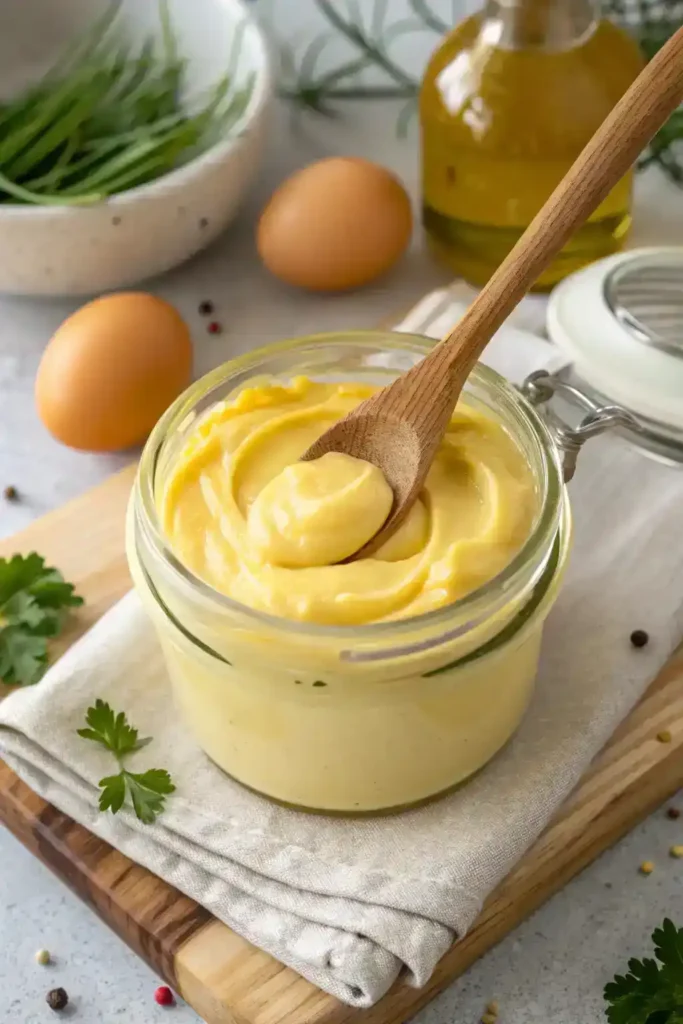
Mix in sriracha, curry powder, pesto, or wasabi to create instant flavor variations. Fresh basil, dill, or chopped sun-dried tomatoes make wonderful herb-infused varieties. Roasted garlic mayo enhances burgers, while cranberry mayo makes turkey sandwiches special.
Chipotle peppers in adobo sauce create smoky notes, and horseradish mayo pairs perfectly with roast beef. In fact, adding your favorite flavoring turns simple mayo into a custom condiment that makes everyday meals special and impresses guests.
Conclusion
Homemade mayonnaise is a simple yet rewarding kitchen project. Fresh ingredients give you complete control over quality, and the superior taste makes this two-minute recipe worth learning.
Store-bought versions might be convenient, but they cannot match the silky texture and rich flavor of fresh mayo. You can create perfect mayonnaise with an immersion blender and simple ingredients that will boost everything from sandwiches to specialty sauces.
Your homemade mayo‘s versatility shines through customization. You can adjust ingredients and add different flavors to create unique spreads and dressings. The technique might take a few attempts to perfect, but your creamy, fresh mayonnaise will taste better than any commercial alternative.
Keep your creation in proper storage and use it within two weeks to get the best results. The troubleshooting tips will help if your mayo breaks or needs adjustment. Visit our website recipesnutritious.com to find more delicious homemade condiments and creative meal ideas.
FAQs
Q1. What’s the quickest way to make homemade mayonnaise? Using an immersion blender, you can make homemade mayonnaise in just 2 minutes. Place all ingredients in a tall, narrow container, blend at the bottom for 10-15 seconds until white mayo forms, then slowly move the blender up to incorporate all the oil.
Q2. What are the essential ingredients for homemade mayonnaise? The three main ingredients for homemade mayonnaise are eggs (or egg yolks), oil, and an acid (lemon juice or vinegar). Additional ingredients like mustard, salt, and optional flavorings can enhance the taste and stability.
Q3. Which oil is best for making homemade mayonnaise? Light olive oil, avocado oil, or neutral oils like sunflower or safflower work well for homemade mayonnaise. Avoid extra-virgin olive oil as its strong flavor can overpower the mayo. Choose a high-quality oil that’s liquid at room temperature for proper emulsification.
Q4. How long does homemade mayonnaise last? Properly stored in an airtight container in the refrigerator, homemade mayonnaise typically lasts about two weeks. For extended freshness up to 30 days, you can add a tablespoon of yogurt whey to the finished mayo.
Q5. How can I fix broken mayonnaise? If your mayonnaise separates or “breaks,” you can fix it by whisking a fresh room-temperature egg yolk in a clean bowl and slowly incorporating the broken mayo. Alternatively, add 1-2 teaspoons of boiling water to the broken mayo and blend immediately to restore the emulsion.

